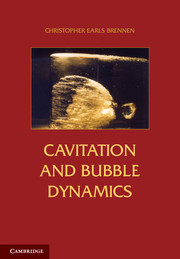8 - Free Streamline Flows
Published online by Cambridge University Press: 05 October 2013
Summary
Introduction
In this chapter we briefly survey the extensive literature on fully developed cavity flows and the methods used for their solution. The terms “free streamline flow” or “free surface flow” are used for those situations that involve a “free” surface whose location is initially unknown and must be found as a part of the solution. In the context of some of the multiphase flow literature, they would be referred to as separated flows. In the introduction to Chapter 6 we described the two asymptotic states of a multiphase flow, homogeneous and separated flow. Chapter 6 described some of the homogeneous flow methods and their application to cavitating flows; this chapter presents the other approach. However, we shall not use the term separated flow in this context because of the obvious confusion with the accepted, fluid mechanical use of the term.
Fully developed cavity flows constitute one subset of free surface flows, and this survey is intended to provide information on some of the basic properties of these flows as well as the methods that have been used to generate analytical solutions of them. A number of excellent reviews of free streamline methods can be found in the literature, including those of Birkkoff and Zarantonello (1957), Parkin (1959), Gilbarg (1960), Woods (1961), Gurevich (1961), Sedov (1966), and Wu (1969,1972). Here we shall follow the simple and elegant treatment of Wu (1969,1972).
- Type
- Chapter
- Information
- Cavitation and Bubble Dynamics , pp. 206 - 246Publisher: Cambridge University PressPrint publication year: 2013



